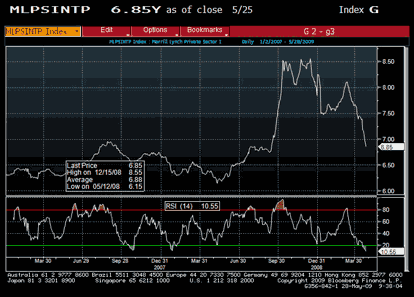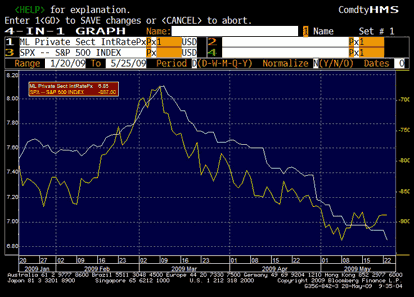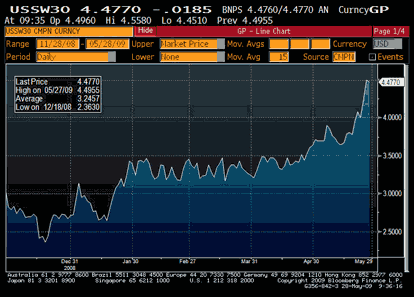For all the talk of “green shoots”, “second derivative improvements”, “positive feedback loops”, and “Chinese stimuli”, perhaps the most important economic development of the year thus far as been sharp fall in credit costs to the US private sector (demonstrated by the Merrill Lynch indicator below.). Putting aside the issue of whether you can borrow your way back to prosperity (hint: you can’t), this development (itself a product of the Fed’s panoply of programs) has been a critical one. Frankly, Macro Man hasn’t paid enough attention to the issue, which is why he has remained considerably more bearish than is good for his P/L.
Because unsurprisingly, there has been a strong correlation between private-sector credit costs and the SPX. Since Obama strode into the White House, even a simple chart overlay demonstrates that the trend in credit costs has been mirrored by the trend in equity markets.
So what, then, are we to make of recent price action? Yesterday’s five-year auction didn’t come off too badly, and indirect bidders once again stepped up to the plate. (We’ll see if they have an appetite for today’s seven-years.) Yet price action in bonds remains little short of execrable. 30 year swap rates have jumped 50 bps in a week, , and conforming 30 year mortgage yields are now litle more than 50 bps above the equivalent Treasury yields.
Sure, the bond sell-off could just be the usual cheapening ahead of supply, but the scale of these moves suggests something deeper (including convexity hedging.) Heck, even LIBOR has started to tick up.
So what does this imply for private sector borrowing costs? And what does that, in turn, suggest for the green shoots/second derivative/confidence boost and, more importantly, for the direction of equities?
Hmmmmmmmm.
- Bulenox: Get 45% to 91% OFF ... Use Discount Code: UNO
- Risk Our Money Not Yours | Get 50% to 90% OFF ... Use Discount Code: MMBVBKSM
Disclaimer: This page contains affiliate links. If you choose to make a purchase after clicking a link, we may receive a commission at no additional cost to you. Thank you for your support!






Leave a Reply